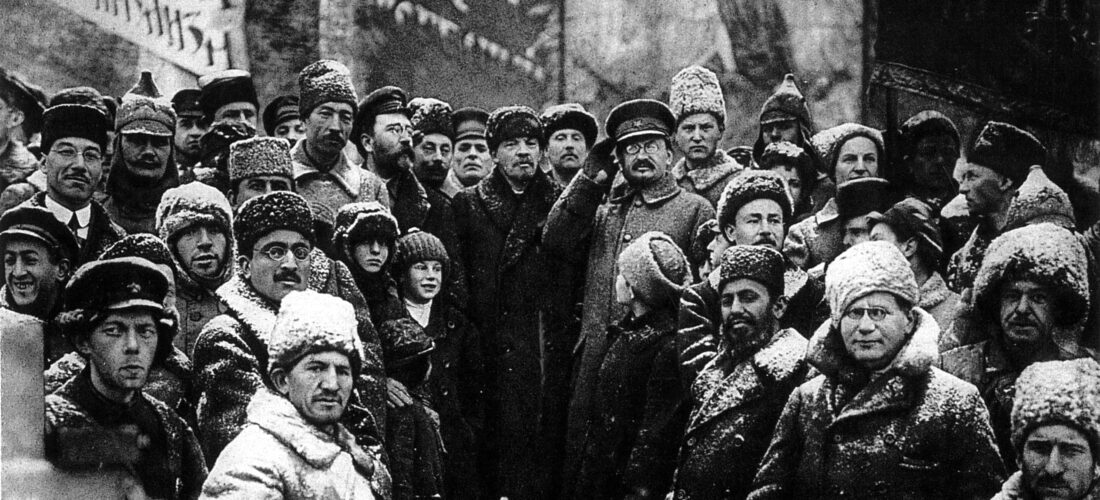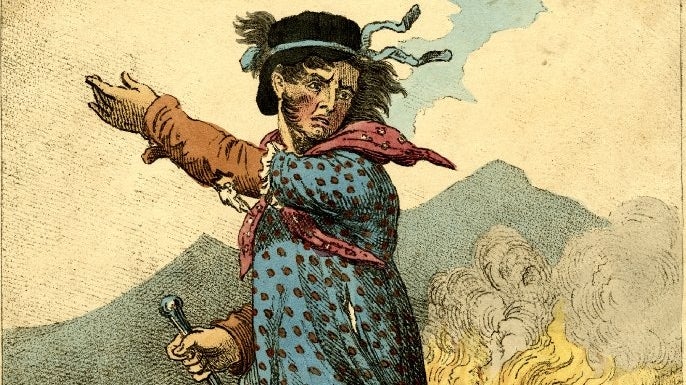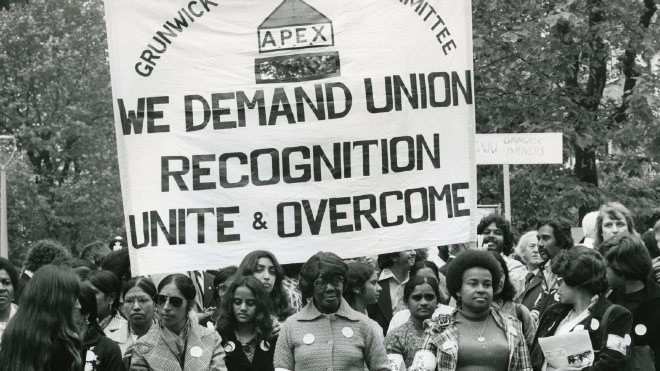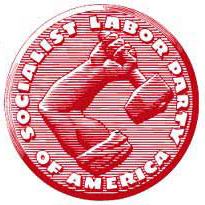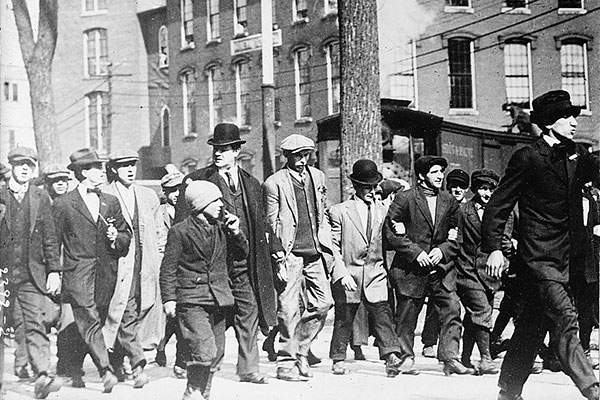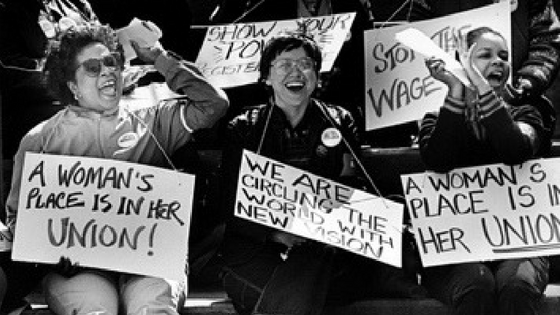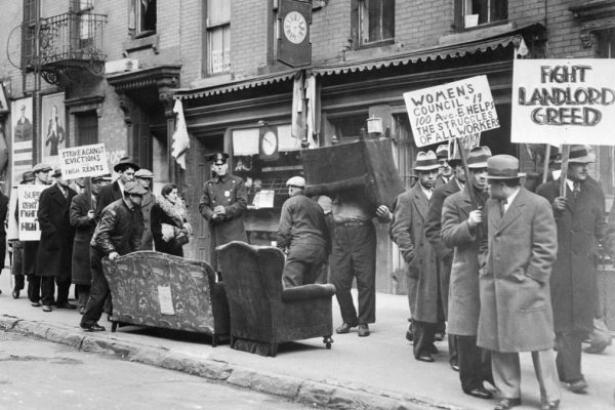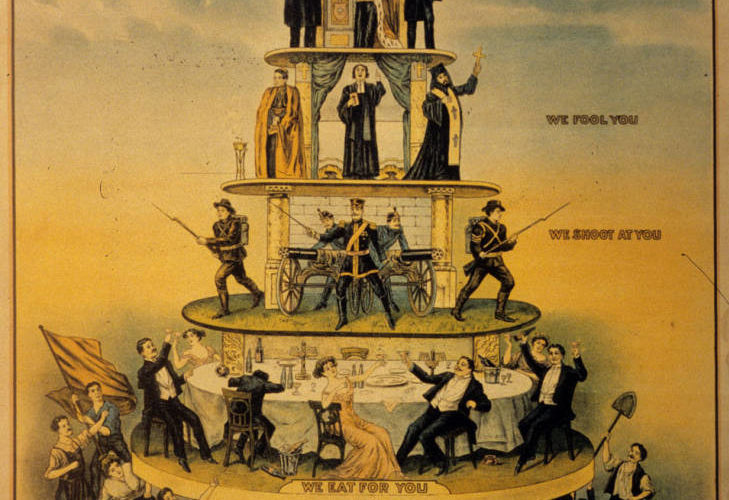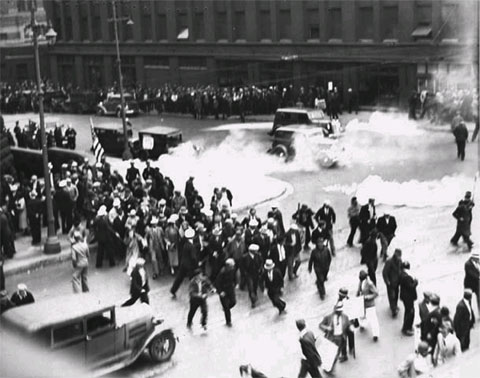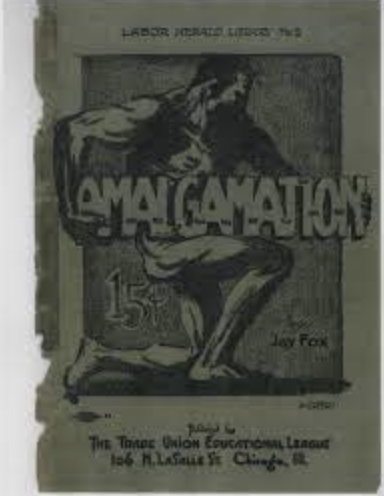This translated text explores the concept of “communization” as a revolutionary strategy, contrasting it with what it labels “programmatism,” the earlier 20th-century approach focused on the proletariat seizing state power. The source argues that programmatism, which aimed to manage the means of production, ultimately failed because it did not challenge the core of capitalist exploitation: the law of value and commodity production. Instead, communization proposes the immediate abolition of capitalist categories like value, wage labor, and social divisions through the self-negation of the proletariat. The authors suggest that the failure of past revolutionary attempts and the restructuring of capitalism in the 1970s necessitate this new approach, one that emphasizes practical, non-commodified actions over predetermined programs or theories.
workers
Ned Lud’s Proclamation (1811)
1700-1830s, Date, Defining the Enemy, Disruptive Spaces, Sabotage/Ecotage, Subjectives of Refusal, Tactics of Disruption, The Bourgeoisie, The Workplace, WorkersThis is a proclamation by Ned Lud, the legendary leader of the Luddites—an early 19th-century movement of English textile workers who protested against the introduction of mechanized looms and knitting frames, fearing these innovations would threaten their livelihoods. The Luddites engaged in direct actions such as destroying machinery and factories, as well as organizing riots and letter-writing campaigns. In this proclamation, Lud issues a death threat to anyone who informs the authorities about the ‘frame-breaking’ activities carried out by the Luddites, who were fighting against the rise of labor-saving technologies.
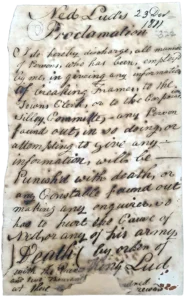
How to Fire Your Boss: A Workers’ Guide to Direct Action – Industrial Workers of the World (1968)
1946-1989, Authority, Date, Defining the Enemy, Disruptive Spaces, Sabotage/Ecotage, Strike, Subjectives of Refusal, Tactics of Disruption, The Bourgeoisie, The Workplace, WorkersThis pamphlet, first released by the Industrial Workers of the World (IWW) in 1968 and revised in 2022, promotes direct action as a powerful tool for workers to secure better conditions at work. It outlines a range of tactics, from slowdowns and work-to-rule strategies to more assertive actions like “marches on the boss” and organizing sick-outs. Emphasizing the critical role of solidarity among workers, the pamphlet includes historical examples of direct action campaigns that have achieved success.
How to Sack Your Boss: A Workers’ Guide to Direct Action (n.d.)
Authority, Defining the Enemy, Disruptive Spaces, Sabotage/Ecotage, Strike, Subjectives of Refusal, Tactics of Disruption, The Bourgeoisie, The Workplace, WorkersThis document is an excerpt from a worker’s guide that promotes direct action against employers. It critiques traditional resistance methods like strikes as ineffective, instead advocating for alternative tactics such as slowdowns, delivering excellent service to disrupt profits, adhering strictly to the rules, and fostering solidarity to compel employers to meet workers’ demands. The author (unknown) offers examples from various industries and historical periods to demonstrate how these methods can be effective, while also emphasizing the potential illegality of many of these actions.
Grunwick Strike (1976-1978)
1946-1989, Date, Defining the Enemy, Privatization, Strike, Subjectives of Refusal, Tactics of Disruption, The Bourgeoisie, Women, WorkersThe Grunwick strike in London involved predominantly Asian women workers at Grunwick Film Processing Laboratories, led by Jayaben Desai. They went on strike demanding better working conditions, fair pay, and union recognition. The strike garnered widespread support from trade unions and labor activists but faced significant opposition, including police violence. Despite the strong solidarity, the strike ended without achieving its goals. However, it is remembered as a key moment in British labor history, highlighting issues of race, gender, and workers’ rights. Below, there are newspaper articles and original photos from their strike efforts.
Homestead Strike (1892)
1840-1945, Date, Defining the Enemy, Disruptive Spaces, Occupation, Privatization, Sabotage/Ecotage, Strike, Subjectives of Refusal, Tactics of Disruption, The Bourgeoisie, The Workplace, Uncategorized, WorkersThe Homestead Strike of 1892, centered at Carnegie’s steel plant in Pennsylvania, marked a pivotal moment in American labor history. It erupted over wage cuts and benefit reductions, leading to a violent clash between striking workers and Pinkerton detectives hired by the company. After Carnegie and his staff pushed workers out of the plant to replace them with non – union workers, they pushed back and barricaded within it. There was violent conflict between them and the Pinkerton detectives. Despite the workers’ efforts, the strike was ultimately suppressed. Nonetheless, the strike remains a significant event in the struggle for workers’ rights and fair labor practices. It became a rallying point for other labor activists.
Luddites Protest (1812)
1700-1830s, Date, Defining the Enemy, Disruptive Spaces, Privatization, Sabotage/Ecotage, Subjectives of Refusal, Tactics of Disruption, The Workplace, Urban Spaces, WorkersDuring the Industrial Revolution in England, textile workers protested against the rise of machinery that took their jobs and reduced their wages. The factory heads and upper class started to push workers out and as a result, they pushed back. This was done through the sabotage of machinery and violently resisting against the people they felt were oppressing them. The PDF below includes pamphlets from this protest that detail the specific actions.
Workers! Students! – Jeunesse Communiste Révolutionnaire (1968)
1946-1989, Authority, Date, Defining the Enemy, Disruptive Spaces, Institutions, Occupation, Privatization, Strike, Students, Subjectives of Refusal, Subjects Redefined, Tactics of Disruption, The Bourgeoisie, The Workplace, Urban Spaces, WorkersJeunesse Communiste Révolutionnaire, a French Trotskyist organization, wrote this piece, describing the transition from a student revolt into a general strike of workers contesting capitalist society during the May 1968 events. The organization included a list of demands and called on other workers and students to join them in the future actions they will take in their fight against the current system.
Statement From Vestas Workers on Their Factory Occupation (2009)
1990-2010, Authority, Date, Defining the Enemy, Disruptive Spaces, Occupation, Privatization, Subjectives of Refusal, Tactics of Disruption, The Bourgeoisie, The Workplace, WorkersOn July 20, 2009, workers of the Vestas Wind Systems factory in Newport, Isle of Wight, occupied the factory after finding out that more than 525 jobs from both the Isle of Wight and the Southampton factories were moving abroad. In their statement, the occupiers called on the government to nationalize the factory, arguing that keeping it open is necessary for the livelihoods of the workers as well as for the health of the planet.
The Construction of Lay Expertise (1995)
1946-1989, 1990-2010, Consciousness Raising, Date, Disruptive Spaces, History, History/Theory, Institutions, Occupation, Tactics of Disruption, The Workplace, Theory, UncategorizedIn the 1980s, the AIDs epidemic began to wreak havoc across the country, specifically amongst gay men. These affected communities felt that the government and other facets of society were not addressing the epidemic properly and so, they were dying in massive proportions. A group of committed activists formed an organization called ACTUP and used disruptive tactics to create more awareness about their issue. One of the most provocative techniques they used was to gather in large amounts and play dead with signs that suggested who was responsible for their death, like the CDC. This paper by Steven Epstein details other such tactics that disrupted people’s every-day movements and oftentimes, forced them to reckon with the AIDs epidemic and its victims.
The Socialist Labor Party – Declaration of Interdependence (1895)
1840-1945, Date, Defining the Enemy, Privatization, Subjectives of Refusal, The Bourgeoisie, WorkersThis document was written by Daniel DeLeon, a prominent leader of the Socialist Labor Party, in 1895. The Socialist Labor Party sought to turn labor movements and unrest into more radical socialist revolutions. In this declaration, DeLeon explores the shortcomings and oppressive nature of capitalism. He then encourages his readers to join the struggle.
“Under that system the toiling masses, hungry and despised, turned the wilderness into a garden, the stones, the clay, the trees into resplendent cities, the ore and the coal into new organs of motion, through which human strength, speed and skill were multiplied a thousandfold, the lightning itself into an obedient messenger; they built factories, ships, docks and warehouses; constructed railroads, bridged rivers and pierced mountains; then descended into their nameless graves, leaving all in the hands of their despoilers, to further oppress and degrade the inheritors of their misery… But throughout the civilized world the wage workers are asserting their interdependence— the natural dependence of every man upon his fellows, of every nation upon all other nations; and under the banner of International Socialism millions of them are now marching to the conquest of the public powers.”
Proclamation of the Striking Textile Workers of Lawrence (1912)
1840-1945, Date, Disruptive Spaces, Strike, Subjectives of Refusal, Tactics of Disruption, The Workplace, WorkersThis document is the proclamation of the striking textile workers of Lawrence, Massachusetts in 1912 – known as the Bread and Roses Strike. The workers went on strike due to the low wages and long hours. This proclamation elaborates on the reasons for their strike and the challenges they have faced at the hands of people in power.
“We, the 20,000 textile workers of Lawrence, are out on strike for the right to live free from slavery and starvation; free from overwork and underpay; free from a state of affairs that had become so unbearable and beyond our control, that we were compelled to march out of the slave pens of Lawrence in united resistance against the wrongs and injustice of years and years of wage slavery.”
Lynching: A Weapon of National Oppression (1932)
1840-1945, Authority, Black, Date, Defining the Enemy, Subjectives of Refusal, White Supremacy, WorkersThis pamphlet was written by Harry Haywood and Milton Howard in 1932 under the direction of the Labor Research Association. The pamphlet states the causes and purposes of lynching, the organization of lynching, laws and resistance against lynching, and more. This document also makes a connection between the class struggle, the exploitation of black workers, and lynching.
“Every one of these Negro workers was murdered as a direct result of the class struggle as expressed in his demand for wages or better conditions from the white landlords who exploit the Negro masses with even greater intensity than they rob the white workers…”
On the General Strike – Bill Haywood (1911)
1840-1945, Date, Disruptive Spaces, Strike, Subjectives of Refusal, Tactics of Disruption, The Workplace, WorkersThis speech was given by Bill Haywood regarding general strikes in countries such as Italy, France, Germany, and Spain. He explains the importance and power of the general strike.
“So the general strike is a fighting weapon as well as a constructive force. It can be used, and should be used, equally as forcefully by the Socialist as by the Industrial Worker.”
Interview with Alzada Clark – Organizing Black Women Workers (1989)
1946-1989, Black, Date, Disruptive Spaces, Subjectives of Refusal, The Workplace, Women, WorkersAlzada Clark organized workers – specifically Black women – in the South, established unions, and participated in the Black Power movement at large. In this interview, she discusses her experiences.
“The Cullmer Company said they beat every union election in the state but one, until “that black woman came around.” They had a lot of respect for me there in the union. They said they couldn’t have organized the women without me.”
“Characteristics of the Early Factory Girls” (1898)
1840-1945, Date, Disruptive Spaces, Subjectives of Refusal, The Workplace, Women, WorkersIn this document, Harriet Hanson Robinson describes women working in factories in the 1830s in Lowell, Massachusetts – from her experience working in a factory starting at 10 years old. The Lowell Factories recruited young women and girls to work in factories. These young women and girls disrupted the workplace, demanding better conditions and wages.
“One of the girls stood on a pump, and gave vent to the feelings of her companions in a neat speech, declaring that it was their duty to resist all attempts at cutting down the wages. This was the first time a woman had spoken in public in Lowell, and the event caused surprise and consternation among her audience.”
Organizing the Unemployed in the Bronx in the 1930s (1949)
1946-1989, Date, Subjectives of Refusal, WorkersThis document is Rose Chernin’s account of the disruption and organizing of the unemployed through the formation of Unemployed Councils. They organized disruptions at places such as grocery stores and organized rent strikes. In this account, Chernin describes the successes, the failures, and her personal thoughts during and after the experiences.
“I, on the other hand, when I talked to people, could convince them to struggle against their conditions. I believed in this struggle. That is all it takes to be an organizer. Belief in our power.”
One Big Union – Industrial Workers of the World (2000)
1990-2010, Date, Defining the Enemy, Disruptive Spaces, Sabotage/Ecotage, Strike, Subjectives of Refusal, Tactics of Disruption, The Bourgeoisie, The Workplace, WorkersThis document, written in 2000 by the Industrial Workers of the World, outlines the organization of workers and the working class. It includes a brief historical discussion, advantages of one union and organization, union and democracy, and direct action.
“A sane world run by producers for the common good is an aim that should be achieved and can be achieved. The I.W.W. can build the sort of labor movement to achieve this. There is really only one big problem in the world: a working class too disorganized to act for its own good. The I.W.W. has the solution to that problem.”
What To Do
Preamble of the Industrial Workers of the World (1908)
1840-1945, Date, Defining the Enemy, Disruptive Spaces, Privatization, Subjectives of Refusal, The Bourgeoisie, The Workplace, WorkersThe Industrial Workers of the World is a worker-led union advocating for and working towards direct action, democracy in the workplace, and unionism. This preamble to their constitution updated their mission and struggle.
“Between these two classes a struggle must go on until the workers of the world organize as a class, take possession of the means of production, abolish the wage system, and live in harmony with the Earth.”
“Eternal Vigilance” – Minneapolis Truckers’ Strike (1934)
1840-1945, Date, Defining the Enemy, Strike, Subjectives of Refusal, Tactics of Disruption, The Bourgeoisie, WorkersThis document was written by James P. Cannon on August 6, 1934 during the Minneapolis Truckers’ Strike. It describes the importance of resisting the violence and remaining persistent in their demands and needs.
“There is no power upon which we can rely except the independent power of the union. Trust in that, and that only. ‘Eternal Vigilance’ is the motto of the hour.”
Organize the Unorganized – Trade Union Educational League (1926)
1840-1945, Date, Defining the Enemy, Disruptive Spaces, Subjectives of Refusal, The Bourgeoisie, The Workplace, WorkersThe Trade Union Educational League was founded in late 1920. It was supported by the Communist Party USA and a majority of members were also members of the Communist Party USA. Its goal was to build a union and workers’ movement. This pamphlet emphasizes the importance of organizing as many workers as possible for the survival and growth of the workers’ movement.
“The organization of the unorganized is a life and death question for the labor movement. To bring the millions into the unions is necessary not only for the protection of the of the un- organized workers, and to further class ends in general, but also to safeguard the life of the existing organizations.”
The World’s Trade Union Movement – Trade Union Educational League (1924)
1840-1945, Consciousness Raising, Date, Defining the Enemy, Subjectives of Refusal, The Bourgeoisie, WorkersThe Trade Union Educational League was founded in late 1920. It was supported by the Communist Party USA and a majority of members were also members of the Communist Party USA. Its goal was to build a union and workers’ movement. This pamphlet is a collection of lectures given by A. Losovsky – the General Secretary of the Red International of Labor Unions – which give a comprehensive, global of the trade union movement.
“There is available a comprehensive picture of the trade union movement from the world viewpoint, which deals not so much with the statics but rather with the vital, living influences at work within the labor movement, the tendencies, the relation of forces and, especially, with the tremendous struggle developing throughout the world since the war by the forces of revolutionary struggle…”
Amalgamation – Trade Union Educational League (1922)
1840-1945, Consciousness Raising, Date, Defining the Enemy, Subjectives of Refusal, The Bourgeoisie, WorkersThe Trade Union Educational League was founded in late 1920. It was supported by the Communist Party USA and a majority of members were also members of the Communist Party USA. Its goal was to build a union and workers’ movement. This pamphlet specifically urges for the unification – “amalgamation” – of trade unions as a way to empower workers and combat capitalism.
“The first stage of the capitalists’ getting together came when they discovered the economy and efficiency of the industrial factory. In the manufacture of a machine the products of several trades are necessary: draftsmen, patternmakers, moulders, blacksmiths, machinists, etc. Why not gather all these crafts together under one roof and one management?”
The Railroaders’ Next Step – Trade Union Educational League (1921)
1840-1945, Date, Defining the Enemy, Disruptive Spaces, Subjectives of Refusal, The Bourgeoisie, The Workplace, WorkersThe Trade Union Educational League was founded in late 1920. It was supported by the Communist Party USA and a majority of members were also members of the Communist Party USA. Its goal was to build a union and workers’ movement. This pamphlet was specifically written for the railroad men.
“As I write this (March, 1921) events are taking shape that render more pressing than ever the need for the utmost possible power and solidarity on the part of all railroad workers. The companies are now making a great drive to crush the unions and to force us down to serfdom… For this threatening struggle railroad men should be prepared with the strongest, closest-knit organization possible.”
Poems for Workers (1920s)
1840-1945, Date, Subjectives of Refusal, WorkersThis document is an anthology of poems written for the working class and dedicated to the workers’ struggle.
“I am the people—the mob—the crowd—the mass.
“I am the People, the Mob” by Carl Sandburg (47)
Do you know that all the great work of the world is done through me?
I am the workingman, the inventor, the maker of the world’s food and clothes.
I am the audience that witnesses history. The Napoleons come from me and the Lincolns, They die. And I send forth more Napoleons and Lincolns.
I am the seed ground. I am a prairie that will stand for much plowing. Terrible storms pass over me. I forget. The best of me is sucked out and wasted. I forget. Everything but Death comes to me and makes me work and give up what I have. And I forget.
Sometimes I growl, shake myself and spatter a few red drops for history to remember. Then—I forget. When I, the People, learn to remember, when I, the People, use the lessons of yesterday and no longer forget who robbed me last year, who played me for a fool—then there w ill be no speaker in all the world say the name: “The People,” with any fleck of a sneer in his voice or any far-off smile of derision.
The mob—the crowd—the mass—will arrive then.
“We are not a movement of an -ism” – Paris (May 1968)
1946-1989, Authority, Date, Defining the Enemy, Disruptive Spaces, Students, Subjectives of Refusal, Urban Spaces, WorkersIn this document, students and workers in Paris in May 1968 explain that reforms are not enough. Destruction and permanent revolution is necessary for the people to prevail.
We currently live in a pre-revolutionary time, hence one of destruction. This permanent struggle, engine of all true progress, will arrive at the revolution, a positive reality, but in no way definitive, for there is no established revolution. And so we say that THE REVOLUTION WILL BE PERMANENT OR IT WILL NOT BE AT ALL.
Workers, Students! – Paris (May 1968)
1946-1989, Authority, Date, Defining the Enemy, Disruptive Spaces, Institutions, Occupation, Self Institution, Students, Subjectives of Refusal, Subjects Redefined, Tactics of Disruption, The Workplace, Urban Spaces, WorkersThis document, written during the events in Paris during May 1968, calls for students and workers to continue the resistance, continue the occupations, and keep their power.
“We must continue to the very end!
We occupy the faculties, the offices, the factories!
We will stay there!
Hunger and Revolt – Cartoons (1935)
1840-1945, Authority, Date, Defining the Enemy, Privatization, Subjectives of Refusal, The Bourgeoisie, WorkersThis book is a collection of cartoons by Jacob Burck that comment on a vide range of political and economic struggles, such as fascism, imperialism, and black liberation, but has an underlying focus capitalism and the worker.
“It is necessary that you penetrate to this reality, that you see the truthful core of these presentations, until, with more and more ardent partisanship and more and more anger, you unite together.”
Henri Barbusse, Introduction
Anatomy of an Industrial Struggle (1976-1978)
1946-1989, Alternative Spaces, Authority, Defining the Enemy, Disruptive Spaces, Sabotage/Ecotage, Strike, Subjectives of Refusal, Subjects Redefined, Tactics of Disruption, The Bourgeoisie, The Workplace, WorkersThis article was written by Garry Hill who worked at the Tonsley Park Chrysler plant in Australia in 1976 during the workers’ struggles – that he actively participated in.
“The text tells of the conflict inside the factory, the rough and tumble of mass meetings, workers’ resistance to production, the tactics of management and the role of the trade union- in this case the notorious Vehicle Builders’ Union.”
